It is time for reading in Ms. Wilson’s (pseudonym) fourth- and fifth-grade class. She names the students who will meet with her and asks that they bring their daybooks. The students who meet with Ms. Wilson retrieve composition books with black and white marbled covers, and they enthusiastically settle into their chairs in the back of the room with the teacher. Purposeful chatter fills the room. Students in the various literacy centers have the same composition books open, busily writing and reading. Karin (first author) witnessed a similar scene every time she visited Ms. Wilson’s classroom.
In this article, we explain what a daybook is, how to organize daybooks, what one teacher included in her daybooks, and how these daybooks helped students to comprehend and discuss texts.
What are daybooks?
Daybooks were first discussed by Donald Murray (1986) in relation to a writer’s notebook. Murray explained how writers use daybooks to make lists, capture ideas, compose a first draft, and play with writing. Brannon, Griffin, Haag, Iannone, Urbanski, and Woodward (2008) later explained how readers and writers use daybooks within the reading and writing classroom to document thinking. Ms. Wilson extended the ideas of Brannon et al. by adding “foldables” (Zike, 2008) to her students’ daybooks and by focusing on comprehension. In this way, the daybook became the reading equivalent of Murray’s writing daybook.
Daybooks offer students a tool to help them understand how to coordinate and organize learning about comprehension strategies while focusing on the content of their text. This organization adds depth to students’ understanding of how to employ the moves of strategic readers. Research by Duke, Pearson, Strachan, and Billman (2010) suggests that such instruction optimizes student comprehension. In the daybook, students produce a systematic record about how to
- organize and track learning with a table of contents,
- recall the metacognitive language of readers,
- employ tools that aid comprehension during reading,
- remember mentor texts (Dorfman & Cappelli, 2007) used to teach comprehension strategies, and
- try out this learning during independent response time.
The comprehension instruction described in this article is based on the comprehension research of proficient readers (Duke, Pearson, Strachan, & Billman, 2010) and how to apply those strategies using tools for understanding (Buehl, 2008; Harvey & Goudvis, 2007; Zike,2008). We define tools for understanding as graphic organizers, foldables, study guides, or charts that students complete as they read. Asking students to add tools for understanding to their daybooks was important for Ms. Wilson because she would find loose, completed Venn diagrams, for example, crammed into binders with papers falling out the sides, wadded and shoved into desks, or worse, thrown in the trash. Later, when Ms. Wilson wanted students to use a Venn diagram, they could not find their work or understand how to use it during independent reading. One student described the daybook as “a place where you aren’t going to lose the things you need to study.”
Organize and track learning
At the beginning of the year, students started their daybooks by labeling the first six pages in the upper right-hand corner, starting with A and ending with F. These pages became the title page and the table of contents. Immediately following, students numbered the pages of their daybooks. Whether students number the front and back of each page is a preference of the teacher. Students began their daybooks with a title page that included information about who to contact in case the daybook was lost (see Figure 1). Students started the table of contents beginning on page B and added information throughout the year in the following sections: 1.) Pop-up Thoughts, 2.) Tools for Understanding, and 3.) Independent Response.
Figure 1. Title Page
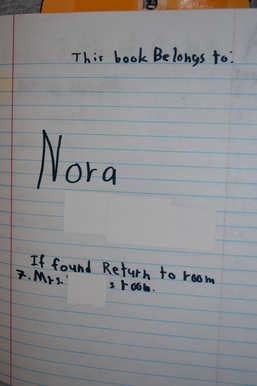
Students in Ms. Wilson’s classroom said the table of contents was the most difficult part. This was especially true for absent students. However, students also felt the table of contents was important because it helped them to stay organized and know what to study. One student said, “I couldn’t keep up with what to label each section of my daybook.” As a result, Ms. Wilson decided one way to help students keep up with the table of contents would be to create file labels each student could stick on the table of contents for specific minilessons (see Figure 2). To help students who were absent, Ms. Wilson decided to keep her own daybook as a model. Students who were absent met with her during center time to catch up on what they missed.
Figure 2. Table of Contents
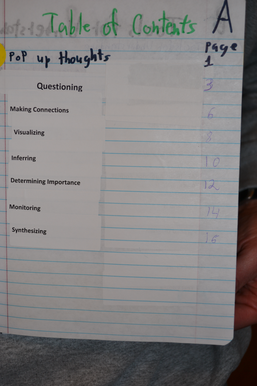
Indeed, the table of contents proved to be difficult, but keeping it allowed students to learn the conventions of a table of contents. Through this work, students began to understand the significance of a table of contents, headings, and subheadings.
Recall metacognitive language of readers
To keep up with the strategies readers use, Ms. Wilson labeled one section of the daybooks Pop-up Thoughts. When Ms. Wilson introduced the idea of metacognition as an inner dialogue, one student claimed he did not understand. He claimed he did not “hear a voice in his head when reading.” Ms. Wilson encouraged the student to continue listening for his own inner dialogue, and perhaps if others shared what their inner voices said, this student might find his own. She continued the lesson, asking students to list what they heard their inner voices say as they read a common text. This same student continued to read and listen as other students discussed and listed their inner dialogue. He suddenly exclaimed, “There it is! I had a pop-up thought.” The whole class celebrated and from that moment on, students referred to their inner dialogue as pop-up thoughts.
Students continued to engage in explicit instruction about metacognitive strategies (i.e., make connections, inferences, questions, fix-up strategies, predictions, visualizations, summarizing, and retelling) and the thoughts that pop up as readers engage with texts (see Figure 3). In this way, Ms. Wilson and her students were able to “have the common language of strategies to discuss insights and ideas about text and content” (Keene & Zimmerman, 2013, p. 604). Based on the belief that sign systems in the external environment are internalized (Vygotsky, 1986), Ms. Wilson associated each pop-up thought with an icon to help readers remember the metacognitive action (see Table). For example, students used an eyeball for visualizing; for inferring, they used a plus sign; for questioning, a question mark. Ms. Wilson adapted a page from Dinah Zike’s (2008) foldables so students could record information about how each strategy helped readers. This allowed Ms. Wilson’s students the opportunity to “make explicit and visible the thinking that goes on in the minds of good readers” (Keene and Zimmermann, 2013, p. 605).
Figure 3. Pop-up Thought: Questioning
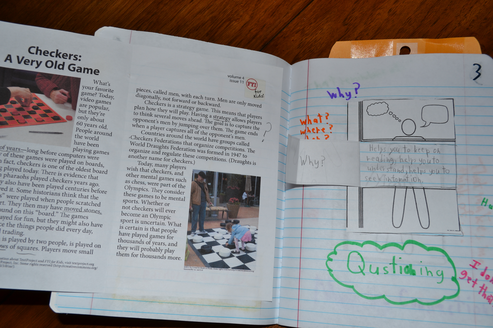
Table 1. Comprehension Strategies Modeled
| Comprehension Strategy | Icon | What | Why | When | Pop-up Thoughts | Mentor Text |
|---|---|---|---|---|---|---|
| Questioning | ? | Wondering about what you are reading, noticing when you are confused | Helps you to keep reading, helps you understand, helps you to seek information | Before, During, and After Reading | I don’t get…, How come…, I wonder…, Why…, Huh?,What…, Where…, When…, | FYI for Kids. (2013). Checkers: A very old game. In FYI for kids,4(11). Retrieved from www.textproject.org/students/fyi-for-kids |
| Making Connections | R | Relating things you have read, seen, done, or heard to the text | To fill in gaps, to help you visualize, to help you apply your understanding to the text | Before, During, and After Reading | That reminds me of…, That makes me think of…, Oh, I get it… | Ditchfield, C. (2004). Freedom of speech. New York, NY: Scholastic. |
| Inferring | + | Involves taking information from the text and merging it with your thinking to come up with an idea the author has not written | To make predictions, to recognize cause and effect, and to determine the author’s purpose | Before, During, and After Reading | Maybe it means…, Perhaps…, The evidence suggests… | Gordon, O. (2007). Cold case file: Murder in the mountains. New York, NY: Bearport Publishing. |
| Monitor Comprehension | Δ | Involves being aware when your reading is muddled or goes amiss | To make sure you understand, to make sure you aren’t “spacing out,” so that you don’t waste your time | Before, During, and After Reading | Wait a second…, I’m not getting this…, Huh? | Woodson, J. (2001). The other side. New York, NY: Putnam Juvenile. |
| Visualizing | ☉ | Involves making a “mind movie” of what is happening in the text | To engage with the text, to connect with what the characters experience | During and After Reading | I can see that…, That is just like…, Wow,that is beautiful. | Say, A. (1993). Grandfather’s journey. New York, NY: Houghton Mifflin. |
| Determining Importance | ! | Sifting through a text to find the most important parts because you can’t remember everything you read | To help you learn to distinguish the big ideas from the details | During and After Reading | This is REALLY important…, I think the big idea is…, This information makes me think… | Marschall, K. (1997). Inside theTitanic: A giant cutaway book. Boston, MA: Little, Brown and Company. |
| Synthesizing | * | Combine new information with existing knowledge to form a new idea or develop a new line of thinking | To think through the factual information to arrive at bigger ideas and reflect on how your thinking changes over time | After Reading | This is really about…, The author wants me to understand…, Oh… | Paulsen, G. (1999<). My life in dog years. New York: Yearling. |
Employ tools that aid comprehension
The Tools for Understanding section helped students understand how to employ tools (i.e., foldable, graphic organizer, study guide, or chart) used during the act of reading to aid comprehension. In this section, Ms. Wilson modeled how to complete the tool for understanding. For example, after teaching students how to question a text, Ms. Wilson wanted students to understand how to construct a B/D/A questioning chart (Buehl, 2008). She asked students to create a three-flap foldable (see Figure 4). Students labeled one flap before, the next flap during, and the final flap after. Using the article “Checkers: A Very Old Game” (FYI for Kids, 2013) as the mentor text, Ms. Wilson wondered aloud about the origin of checkers. She encouraged students to add their own questions based on the pictures and captions. Students recorded these questions under the before flap, since the questions arose before reading the article. She continued to read, pausing when she came to the section where the author described playing the game, and she wondered what players used for tokens. She told the class, “I’ll write this question under the during flap and I’ll keep reading to see if I find an answer.” She also paused when she finished reading and lifted the after flap, saying aloud, “I wonder why they capture all the opponent’s men.” After finishing, Ms. Wilson asked students to read through their questions to place a check by those answered in the text. She also discussed the possibility that some of the questions that did not have checks required readers to infer, or use their own background knowledge to answer, while others might require readers to do additional reading. Ms. Wilson also asked students to write a brief synthesis about the content of their reading at the bottom of the B/D/A questioning chart. Finally, she invited students to create a similar B/D/A questioning chart during independent reading.
Figure 4. BDA Questioning Chart
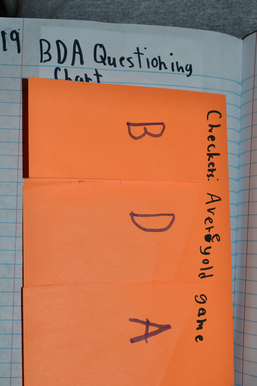
These Tools for Understanding offered students a way to engage with texts rather than skim for answers, process text at a surface level, or read and forget (Buehl, 2008). Students used the Tools for Understanding with various texts so they had an understanding of how to use these tools with multiple texts. For example, students explored sketch to stretch (Allen, 2007) when they learned about visualizing withGrandfather’s Journey (see Figure 5; Say, 1993). They also learned how to code texts by writing the icons associated with each strategy on sticky notes, then using those sticky notes (see Figure 6) during small-group discussions to synthesize their learning with My Life in Dog Years (Paulsen, 1999).
Figure 5. Visualizing with Sketch-to-Stretch
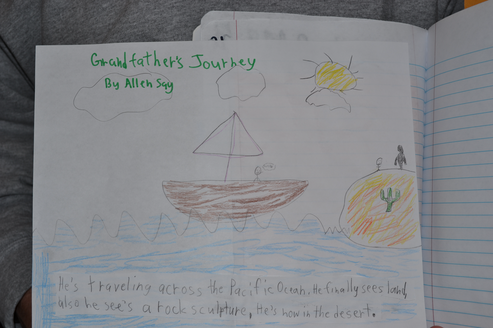
Figure 6. Text-coding for Small-group Discussions
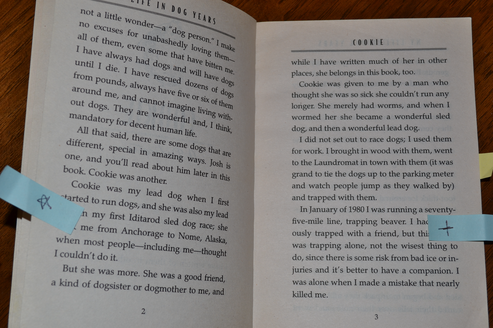
Remember mentor texts
As students learned about each of the comprehension strategies and the tools for understanding, Ms. Wilson asked students to make note of the mentor texts used to teach the strategies. Often, Ms. Wilson used a photocopy of an article or paragraph from a book to explicitly teach students how to use the comprehension strategy and to engage in a close read (Fisher & Frey, 2012). When this was the case, she asked readers to glue the article or paragraph into their daybooks (see Figure 3). Because students had quick access to the mentor texts used in class and their notes on these texts, they were likely to remember the texts, the strategies, and the tools for understanding used to aid comprehension. Students often referred to this section of their daybooks during independent reading.
Learning during independent reading
In the final section, Independent Response, Ms. Wilson asked students to complete a tool for understanding as they independently read and when they read books assigned for small-group reading. Students referred to the Tools for Understanding section to decide on a tool that would aid their comprehension. During small-group reading, students discussed which of the tools for understanding they used and how the tool helped them make meaning. There were occasions when students struggled because they did not fully understand a tool. For example, one student listed questions already explicitly stated in the book rather than his own questions on his B/D/A questioning chart. Ms. Wilson used this time to review how to use the tool for understanding and whether the content students were reading fit with the tool for understanding.
As the year progressed, students flexibly used comprehension strategies and made decisions about how to document their thinking. Ms. Wilson demonstrated and encouraged students to use their daybooks to engage in conversations about their reading. One student explained how these discussions helped her learn, saying, “Discussing and then sharing their ideas with me and then putting them together, that helped me the best.” Another student explained, “If I needed to go back and check on something, I could just go in here [the daybook] and look for what I needed to know.” He added that he used the daybook to help him remember what he needed to do as a reader. One student explained further: “We’ve done lots of projects with foldables. It is easier to remember if you can do it physically instead of reading it out of a book. The daybook has helped me to remember what to do.”
Closing thoughts
Overall, daybooks enhanced students’ understanding of comprehension strategies and how to document understanding about what they read. Ms. Wilson’s fourth and fifth graders created a document with the potential to carry and extend their learning for years to come. Through daybooks, students learned about comprehension strategies, tools for understanding that visually represented their thoughts, how to apply tools for understanding in the context of reading, and how to use tools for understanding during independent reading and small-group discussions. Regardless of the sections in the daybook or how the daybook is structured, students find the daybook helpful. Rather than stuffing their work into an overflowing binder or throwing their graded work in the trash, students organize their daybooks using the table of contents and glue foldables into their daybooks, making them living documents that students use over and over to respond to their classmates and engage in independent reading. One student summed up her thoughts about daybooks by saying, “It’s like a book for your mind.”
Keith, Karin J. & Pridemore, Celeste B. (2014). Daybooks: A Book for Your Mind. The Reading Teacher, 68(1), 46–51 doi: 10.1002/trtr.1300
